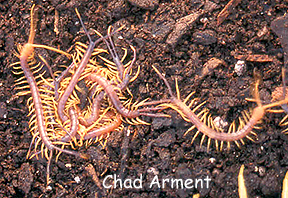Giant redheaded centipede
Order: Scolopendromorpha
Family: Scolopendridae
Genus and species: Scolopendra heros Girard



These fast moving and aggressive titans are among the largest of the many-legged centipedes and millipedes, the group collectively known as the Myriapoda. Centipedes are distinguished from millipedes by the presence of only one pair of legs per body segment, and their legs are attached to the sides of the body segments rather than near the ventral midline. They comprise the Class Chilopoda, which scientists divide into four orders. Giant centipedes are in the Order Scolopendromorpha, which is distinguished by having 21 or 23 pairs of legs and, usually, four small, individual ocelli on each side of the head. The closely related Geophilomorpha lack eyes. Most Scutigeromorpha (of which there is only one North American species) and Lithobiomorpha have eyes similar to the compound eyes of insects, each consisting of up to 200 optical units similar to ommatidia, and adults in these two orders have only 15 pairs of legs.
Giant redheaded centipedes are not frequently observed or collected, but those that make themselves known attract a great deal of attention because of their size and fierce appearance. Specimens average about 6 ½” in length, and they may reach nearly 8” in some instances. They have been called “giant desert centipedes,” but this appears to be a misnomer because the centipedes are often collected in rocky woodland in Arkansas. The species is also known to occur at least in Arkansas, southern Missouri, Louisiana, Kansas, Oklahoma, Texas, New Mexico, Arizona, and northern Mexico. Within Arkansas, we have reliable reports of this species from Benton, Carroll, Washington, Crawford, Sebastian, Perry, Pulaski, Garland, Hot Spring, Pike, and Howard Counties. The easternmost record for the species comes from Little Rock, Pulaski County. In the 1920s, William Baerg, head of the Entomology Department at the University of Arkansas (Fayetteville), regarded the giant redheaded centipede as rather common near Little Rock and in Northwest Arkansas. His limited experience with the species indicated that it occurred “in certain more or less restricted localities, where it can be found, at least during the warmer seasons, under stones and logs.”
Scolopendra heros has many color variants, but Arkansas specimens have the so-called castaneiceps pattern in which the head and first two body segments are chestnut red, the trunk is black tinged with green, and the first 20 pairs of legs are yellow. The enlarged legs of the 21st pair at the posterior end of the centipede are black with yellow tips. This bright coloration is known as aposematic coloration or warning coloration and it is presumed to function in warding off potential predators by advertising the centipedes’ confrontational character and poisonous qualities while it goes about its daytime activities.
All centipedes are believed to be predators. Their diet is composed primarily of small arthropods, although some scolopendromorphs have been found feeding on toads, small snakes, and other vertebrates. Moths are a preferred diet for captive giant redheaded centipedes. The prey is captured and killed or stunned with the poison claws. Poison glands are located in the basal segments of the claws or fangs, sometimes called maxillipeds. Each gland drains its toxic contents through a small opening near the tip of the fang. In the mid 1920s, Dr. Baerg tested the effect of the venom by inducing a centipede to bite one of his little fingers, leaving the fangs inserted for about four seconds. The bite was followed by a sharp and strictly local pain, which began to subside noticeably after about 15 minutes. In about two hours the pain was only very slight, but there was a general swelling in the finger. Three hours after the bite, most symptoms had disappeared.
Scolopendra heros is purported to make tiny incisions with its legs while walking across human skin. When the animal is irritated, a poison is supposedly produced near the base of each leg and dropped into the wounds causing inflammation and irritation. According to one story cited by Dr. Baerg, an officer in the Confederate Army, while sleeping in his tent, was suddenly aroused by the creepy feeling of a large centipede crawling on his chest. A number of spots of deep red, forming a broad streak, indicated the arthropod’s passage across the man’s chest and abdomen. Violent pain and convulsions soon set in, accompanied by excessive swelling in the bitten area. The victim fought with death for two days and then succumbed. The agony suffered by the bitten officer was described by an eyewitness as the most frightful he had ever observed. The famed arthtopod scientist J. L. Cloudsley-Thompson once explained that “centipedes seem to exert a weird fascination on the morbid appetites of the hysterical and insane.”
Scolopendromorphs lay eggs, often in cavities hollowed out in pieces of decayed wood, and then they watch over them and the juveniles that hatch. The female winds herself around the egg mass, her legs directed toward the eggs. Scolopendromorph and geophilomorph juveniles possess the same number of legs as do the adults. Juveniles of the other centipede orders have only seven pairs of legs on hatching. S. heros are nearly colorless when freshly hatched, but they soon turn brown, and they eventually take on the distinctive color pattern of the adult.
References:
Baerg, W. J. 1924. The effect of the venom of some supposedly poisonous arthropods. Annals of the Entomological Society of America 17: 343-352.
Barnes, R. D. Invertebrate zoology, second edition. W. B. Saunders Company, Philadelphia. 743 pages.
Bollman, C. H. 1888. A preliminary list of the Myriapoda of Arkansas, with descriptions of new species. Entomologica Americana 4: 1-8.
Cloudsley-Thompson, J. L. 1968. Spiders, scorpions, centipedes and mites. Pergamon Pres, Oxford. 278 pages.
Shelley, R. 2002. A synopsis of the North American centipedes of the order Scolopendromorpha (Chilopoda). Virginia Museum of Natural History Memoir 5: 108 pages.
